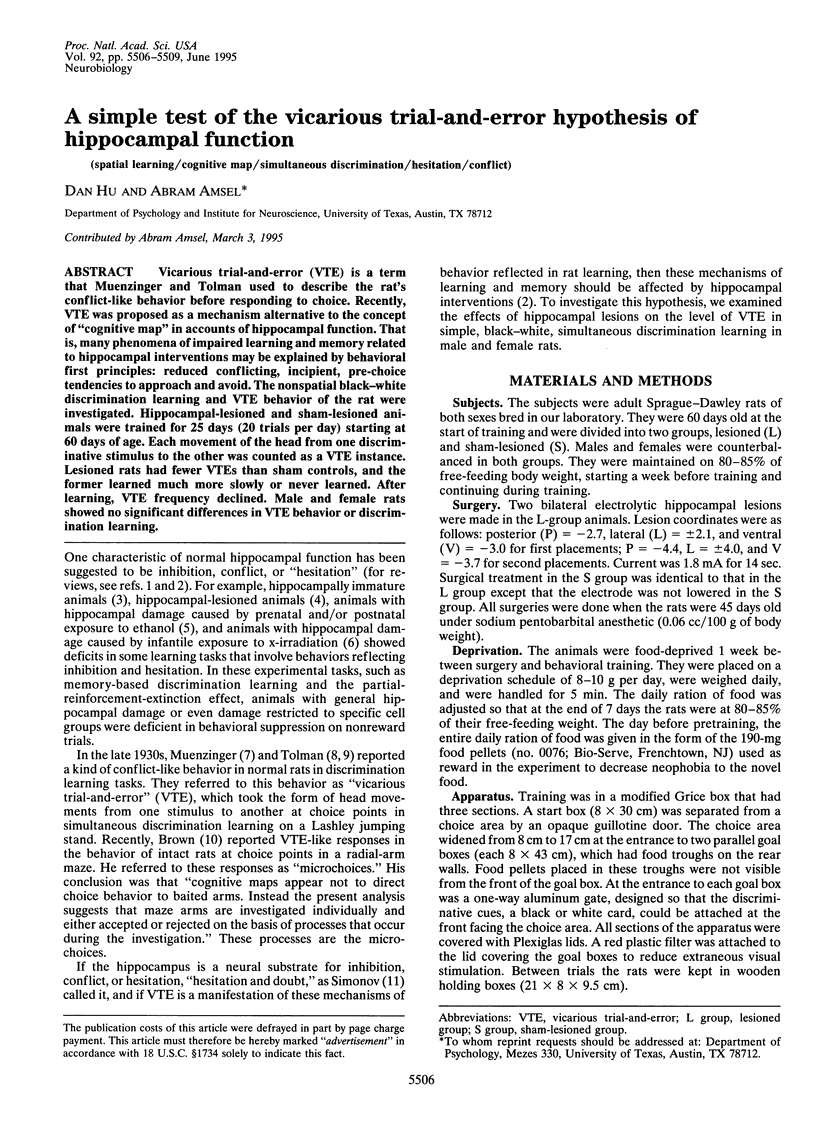Abstract
Vicarious trial-and-error (VTE) is a term that Muenzinger and Tolman used to describe the rat's conflict-like behavior before responding to choice. Recently, VTE was proposed as a mechanism alternative to the concept of "cognitive map" in accounts of hippocampal function. That is, many phenomena of impaired learning and memory related to hippocampal interventions may be explained by behavioral first principles: reduced conflicting, incipient, pre-choice tendencies to approach and avoid. The nonspatial black-white discrimination learning and VTE behavior of the rat were investigated. Hippocampal-lesioned and sham-lesioned animals were trained for 25 days (20 trials per day) starting at 60 days of age. Each movement of the head from one discriminative stimulus to the other was counted as a VTE instance. Lesioned rats had fewer VTEs than sham controls, and the former learned much more slowly or never learned. After learning, VTE frequency declined. Male and female rats showed no significant differences in VTE behavior or discrimination learning.
Full text
PDF



Images in this article
Selected References
These references are in PubMed. This may not be the complete list of references from this article.
- Amsel A. Hippocampal function in the rat: cognitive mapping or vicarious trial and error? Hippocampus. 1993 Jul;3(3):251–256. doi: 10.1002/hipo.450030302. [DOI] [PubMed] [Google Scholar]
- Cahusac P. M., Rolls E. T., Miyashita Y., Niki H. Modification of the responses of hippocampal neurons in the monkey during the learning of a conditional spatial response task. Hippocampus. 1993 Jan;3(1):29–42. doi: 10.1002/hipo.450030104. [DOI] [PubMed] [Google Scholar]
- Deadwyler S. A., West M., Lynch G. Activity of dentate granule cells during learning: differentiation of perforant path input. Brain Res. 1979 Jun 15;169(1):29–43. doi: 10.1016/0006-8993(79)90371-8. [DOI] [PubMed] [Google Scholar]
- Deadwyler S. A., West M., Lynch G. Synaptically identified hippocampal slow potentials during behavior. Brain Res. 1979 Feb 2;161(2):211–225. doi: 10.1016/0006-8993(79)90064-7. [DOI] [PubMed] [Google Scholar]
- Gray J. A., McNaughton N. Comparison between the behavioural effects of septal and hippocampal lesions: a review. Neurosci Biobehav Rev. 1983 Summer;7(2):119–188. doi: 10.1016/0149-7634(83)90014-3. [DOI] [PubMed] [Google Scholar]
- Greene P. L., Diaz-Granados J. L., Amsel A. Blood ethanol concentration from early postnatal exposure: effects on memory-based learning and hippocampal neuroanatomy in infant and adult rats. Behav Neurosci. 1992 Feb;106(1):51–61. doi: 10.1037//0735-7044.106.1.51. [DOI] [PubMed] [Google Scholar]
- Lobaugh N. J., Bootin M., Amsel A. Sparing of patterned alternation but not partial reinforcement effect after infant and adult hippocampal lesions in the rat. Behav Neurosci. 1985 Feb;99(1):46–59. doi: 10.1037//0735-7044.99.1.46. [DOI] [PubMed] [Google Scholar]
- Nadel L. The hippocampus and space revisited. Hippocampus. 1991 Jul;1(3):221–229. doi: 10.1002/hipo.450010302. [DOI] [PubMed] [Google Scholar]
- Simonov P. V. Studies of emotional behavior of humans and animals by Soviet physiologists. Ann N Y Acad Sci. 1969 Jul 30;159(3):1112–1121. doi: 10.1111/j.1749-6632.1969.tb13001.x. [DOI] [PubMed] [Google Scholar]



